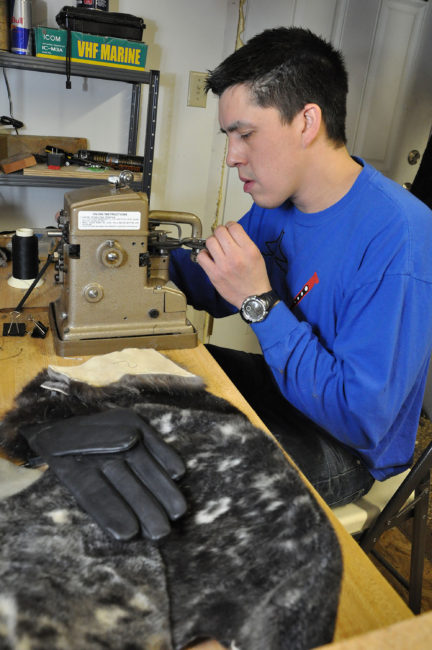
What makes a person Alaska Native?
In some places, a regulatory definition — known as blood quantum — has superseded cultural ones.
And a new study by the Sealaska Heritage Institute in Juneau tackles how that regulatory definition applies to marine mammal hunters.
According to the federal government, Nathan Soboleff is one-eighth Tlingit and one-eighth Haida descent. He said he’s got some Norwegian and Russian mixed in there too. He identifies most strongly with his Tlingit roots.
“My father’s and grandfather’s people have been here since time immemorial and my mother’s side of the family has been here seven or eight generations as Norwegian fishermen. Juneau is my lifelong home,” Soboleff said.
Nathan’s family name is well-known in Juneau. The Sealaska Heritage Institute building is named after his grandfather, Tlingit elder Walter Soboleff. His great-uncle Vincent Soboleff is a Russian-American photographer who documented Tlingit life at the turn of the last century.
“There aren’t a lot of Soboleffs in Juneau but we have left a bit of a mark,” he said.
Soboleff also has deep ties to his culture. He’s on the board of directors for the Kootznoowoo village corporation for Angoon. And he’s an outspoken advocate of the importance of cultural heritage.
But, in the lineage math used for certifying degree of Indian blood, Soboleff has a one-fourth blood quantum.
That amount is calculated by the federal government, using ancestors with Indian blood who were enrolled in federally recognized Indian tribes or whose names appeared on the rolls of federally recognized tribes.
That means he’s got just enough of a blood quantum to qualify as a descendant shareholder of the Sealaska corporation. Of the regional corporations that enroll descendants, all but one — Calista — require a minimum blood quantum.
It also means that, as a subsistence hunter in Southeast Alaska, he can harvest sea otters, harbor seals and Steller sea lions.
Those animals are protected under the Marine Mammal Protection Act, but Alaska Natives who live in coastal areas are exempt and allowed to hunt them for food and clothing or to make handicrafts to sell.
But that right isn’t afforded to all Alaska Natives. They have to have a blood quantum of a quarter or more.
Soboleff can hunt, but he married a non-Native woman. And his kids?
“My children are less than that,” he said.
Soboleff’s daughter and sons can watch him hunt and harvest, prepare the carcasses for food or ceremony — but they can’t drive the boat or help him haul the dead animals on board. They can’t help him sew the hides or prepare seal oil.
He said using the blood quantum interpretation as a requirement for harvest has limited his ability to teach his children their cultural heritage.
“If you take that interpretation and move forward in time just a couple of years, you’re really preventing future descendants of the culture of learning their ways,” he said.
And Soboleff’s family isn’t alone.
According to the Sealaska Heritage Institute’s study, the number of Alaska Natives who meet the one-fourth blood quantum threshold is dropping.
In the last decade, nearly 20,000 Alaska Natives enrolled with the Bureau of Indian Affairs had less than that one-fourth blood quantum, according to the agency.
The heaviest hit are communities in the Gulf of Alaska where nearly 60 percent of newly enrolled Alaska Natives don’t meet the threshold.
And, beyond the loss of subsistence hunting privileges, Soboleff said the blood quantum restriction is creating divisions within the Alaska Native community.
“It creates a class of Native peoples. It separates them,” he said. “It specifically breaks them into two groups, those who can hunt, harvest and use those marine mammals and those who cannot.”
Through personal interviews, the study found that most Alaska Natives would like to see the blood quantum criteria changed. It lays out several ways that could happen.
It includes changing the blood quantum threshold to one-eighth. Though, the same eligibility issue could pop up again in a few decades. Tribal enrollment could be used, but some tribes require a minimum blood quantum.
Rosita Worl is the president of the Sealaska Heritage Institute and an anthropologist who helped guide the research in the study.
“I heard grandfathers talking about how they couldn’t take their grandsons out hunting. I heard other grandfathers talk about being able to take one child out who had the one-quarter blood quantum, but not another who did not meet the eligibility requirements,” she said.
She presented the results of the study at the Alaska Federation of Natives conference in Fairbanks in October.
It’s not the first time the issue has been discussed at the conference. In 2010, the Koniag regional corporation proposed changing the definition of Alaska Native to include lineal descendants with less than one-fourth blood quantum.
But, Worl said it was controversial.
“We didn’t know how many new members that would be,” she said. “Are we talking about a whole new population of 30,000 hunters coming into hunt? You know we just had absolutely no idea.”
Now that the new study makes that data available, she said the next step is for tribal entities to take the research back to their regions and decide if, and how, they might want to change the hunting requirements.
Once they’ve got consensus, they’ll have to take their request to Congress.
Editor’s note: This story has been updated to show that the Sealaska Heritage Institute building was named after Walter Soboleff.
